Local Clays from China as Alternative Hemostatic Agents
Abstract
:1. Introduction
2. Results
2.1. Characterization
2.2. Zeta Potentials
2.3. Water Absorption
2.4. Cytotoxicity Studies
2.5. Plasma Clotting Assay
2.6. In Vitro Blood Clotting Test
3. Discussion
4. Methods
4.1. Materials
4.2. Characterization
4.3. Zeta-Potential
4.4. Water Absorption
4.5. Cytotoxicity Study
4.6. Plasma Clotting Assay
4.7. In Vitro Blood Clotting Test
4.8. Statistical Analysis
Author Contributions
Funding
Institutional Review Board Statement
Informed Consent Statement
Data Availability Statement
Conflicts of Interest
References
- Udangawa, R.N.; Mikael, P.E.; Mancinelli, C.; Chapman, C.; Willard, C.F.; Simmons, T.J.; Linhardt, R.J. Novel Cellulose-Halloysite Hemostatic Nanocomposite Fibers with a Dramatic Reduction in Human Plasma Coagulation Time. ACS Appl. Mater. Interfaces 2019, 11, 15447–15456. [Google Scholar] [CrossRef]
- Khatoon, N.; Chu, M.Q.; Zhou, C.H. Nanoclay-based drug delivery systems and their therapeutic potentials. J. Mater. Chem. B 2020, 8, 7335–7351. [Google Scholar] [CrossRef]
- Cui, Y.; Huang, Z.; Lei, L.; Li, Q.; Jiang, J.; Zeng, Q.; Tang, A.; Yang, H.; Zhang, Y. Robust hemostatic bandages based on nanoclay electrospun membranes. Nat. Commun. 2021, 12, 5922. [Google Scholar] [CrossRef]
- Zheng, Y.; Wu, J.; Zhu, Y.; Wu, C. Inorganic-based biomaterials for rapid hemostasis and wound healing. Chem. Sci. 2022, 14, 29–53. [Google Scholar] [CrossRef]
- Baysal, G.; Aydın, H.; Uzan, S.; Hoşgören, H. Investigation of Antimicrobial Properties of QASs+ (Novel Synthesis). Russ. J. Phys. Chem. B 2018, 12, 695–700. [Google Scholar] [CrossRef]
- Wan, Y.; Fang, J.; Wang, Y.; Sun, J.; Sun, Y.; Sun, X.; Qi, M.; Li, W.; Li, C.; Zhou, Y.; et al. Antibacterial Zeolite Imidazole Frameworks with Manganese Doping for Immunomodulation to Accelerate Infected Wound Healing. Adv. Healthc. Mater. 2021, 10, e2101515. [Google Scholar] [CrossRef]
- Rius-Rocabert, S.; Arranz-Herrero, J.; Fernández-Valdés, A.; Marciello, M.; Moreno, S.; Llinares-Pinel, F.; Presa, J.; Hernandez-Alcoceba, R.; López-Píriz, R.; Torrecillas, R.; et al. Broad virus inactivation using inorganic micro/nano-particulate materials. Mater. Today Bio 2022, 13, 100191. [Google Scholar] [CrossRef]
- Yang, Y.; Wang, X.; Yang, F.; Mu, B.; Wang, A. Progress and future prospects of hemostatic materials based on nanostructured clay minerals. Biomater. Sci. 2023. [Google Scholar] [CrossRef]
- Prinz Setter, O.; Segal, E. Halloysite nanotubes–the nano-bio interface. Nanoscale 2020, 12, 23444–23460. [Google Scholar] [CrossRef]
- Salvestrini, S.; Debord, J.; Bollinger, J.-C. Enhanced Sorption Performance of Natural Zeolites Modified with pH-Fractionated Humic Acids for the Removal of Methylene Blue from Water. Molecules 2023, 28, 7083. [Google Scholar] [CrossRef]
- Souza, I.M.S.; Borrego-Sánchez, A.; Sainz-Díaz, C.I.; Viseras, C.; Pergher, S.B.C. Study of Faujasite zeolite as a modified delivery carrier for isoniazid. Mater. Sci. Eng. C Mater. Biol. Appl. 2021, 118, 111365. [Google Scholar] [CrossRef]
- Fizir, M.; Dramou, P.; Dahiru, N.S.; Ruya, W.; Huang, T.; He, H. Halloysite nanotubes in analytical sciences and in drug delivery: A review. Mikrochim. Acta 2018, 185, 389. [Google Scholar] [CrossRef]
- Zhao, P.; Feng, Y.; Zhou, Y.; Tan, C.; Liu, M. Gold@Halloysite nanotubes-chitin composite hydrogel with antibacterial and hemostatic activity for wound healing. Bioact. Mater. 2023, 20, 355–367. [Google Scholar] [CrossRef]
- Rozhina, E.; Batasheva, S.; Danilushkina, A.; Kryuchkova, M.; Gomzikova, M.; Cherednichenko, Y.; Nigamatzyanova, L.; Akhatova, F.; Fakhrullin, R. Kaolin alleviates the toxicity of graphene oxide for mammalian cells. MedChemComm 2019, 10, 1457–1464. [Google Scholar] [CrossRef]
- Kim, K.; Shim, H.; Jung, P.Y.; Kim, S.; Choi, Y.U.; Bae, K.S.; Lee, J.K.; Jang, J.Y. Effectiveness of kaolin-impregnated hemostatic gauze use in preperitoneal pelvic packing for patients with pelvic fractures and hemodynamic instability: A propensity score matching analysis. PLoS ONE 2020, 15, e0236645. [Google Scholar] [CrossRef]
- Liang, Y.; Xu, C.; Liu, F.; Du, S.; Li, G.; Wang, X. Eliminating Heat Injury of Zeolite in Hemostasis via Thermal Conductivity of Graphene Sponge. ACS Appl. Mater. Interfaces 2019, 11, 23848–23857. [Google Scholar] [CrossRef]
- Li, J.; Cao, W.; Lv, X.X.; Jiang, L.; Li, Y.J.; Li, W.Z.; Chen, S.Z.; Li, X.Y. Zeolite-based hemostat QuikClot releases calcium into blood and promotes blood coagulation in vitro. Acta Pharmacol. Sin. 2013, 34, 367–372. [Google Scholar] [CrossRef]
- Mei, L.; Yi, Z.; Peng, H.; Shi, C.; Yang, H. Emerging Nanoclay Composite for Effective Hemostasis. Adv. Funct. Mater. 2018, 28, 1704452. [Google Scholar]
- Pourshahrestani, S.; Zeimaran, E.; Djordjevic, I.; Kadri, N.A.; Towler, M.R. Inorganic hemostats: The state-of-the-art and recent advances. Mater. Sci. Eng. C Mater. Biol. Appl. 2016, 58, 1255–1268. [Google Scholar] [CrossRef]
- Awad, M.E.; López-Galindo, A.; Setti, M.; El-Rahmany, M.M.; Iborra, C.V. Kaolinite in pharmaceutics and biomedicine. Int. J. Pharm. 2017, 533, 34–48. [Google Scholar] [CrossRef]
- De Silva, R.T.; Dissanayake, R.K.; Mantilaka, M.; Wijesinghe, W.; Kaleel, S.S.; Premachandra, T.N.; Weerasinghe, L.; Amaratunga, G.A.J.; de Silva, K.M.N. Drug-Loaded Halloysite Nanotube-Reinforced Electrospun Alginate-Based Nanofibrous Scaffolds with Sustained Antimicrobial Protection. ACS Appl. Mater. Interfaces 2018, 10, 33913–33922. [Google Scholar] [CrossRef]
- Maximov, P.; Dasi, E.; Kalinina, N.; Ruban, A.; Pokidko, B.; Rudmin, M. Zinc-Intercalated Halloysite Nanotubes as Potential Nanocomposite Fertilizers with Targeted Delivery of Micronutrients. Materials 2023, 16, 6729. [Google Scholar] [CrossRef]
- Bayram, A.; Arkan, E.; Sutcu, M. Toxic gas removal with kaolinite, metakaolinite, radiolarite, and diatomite. Chemosphere 2023, 314, 137707. [Google Scholar] [CrossRef]
- Sadjadi, S.; Akbari, M.; Heravi, M.M. Palladated Nanocomposite of Halloysite-Nitrogen-Doped Porous Carbon Prepared from a Novel Cyano-/Nitrile-Free Task Specific Ionic Liquid: An Efficient Catalyst for Hydrogenation. ACS Omega 2019, 4, 19442–19451. [Google Scholar] [CrossRef]
- Bediako, E.G.; Nyankson, E.; Dodoo-Arhin, D.; Agyei-Tuffour, B.; Łukowiec, D.; Tomiczek, B.; Yaya, A.; Efavi, J.K. Modified halloysite nanoclay as a vehicle for sustained drug delivery. Heliyon 2018, 4, e00689. [Google Scholar] [CrossRef]
- Santos, A.C.; Pereira, I.; Reis, S.; Veiga, F.; Saleh, M.; Lvov, Y. Biomedical potential of clay nanotube formulations and their toxicity assessment. Expert Opin. Drug Deliv. 2019, 16, 1169–1182. [Google Scholar] [CrossRef]
- Gaaz, T.S.; Sulong, A.B.; Kadhum, A.A.H.; Al-Amiery, A.A.; Nassir, M.H.; Jaaz, A.H. The Impact of Halloysite on the Thermo-Mechanical Properties of Polymer Composites. Molecules 2017, 22, 838. [Google Scholar] [CrossRef]
- Hangge, P.; Stone, J.; Albadawi, H.; Zhang, Y.S.; Khademhosseini, A.; Oklu, R. Hemostasis and nanotechnology. Cardiovasc. Diagn. Ther. 2017, 7, S267–S275. [Google Scholar] [CrossRef]
- Cha, W.; Jeong, N.C.; Song, S.; Park, H.J.; Thanh Pham, T.C.; Harder, R.; Lim, B.; Xiong, G.; Ahn, D.; McNulty, I.; et al. Core-shell strain structure of zeolite microcrystals. Nat. Mater. 2013, 12, 729–734. [Google Scholar] [CrossRef]
- Shelyakina, M.K.; Soldatkin, O.O.; Arkhypova, V.M.; Kasap, B.O.; Akata, B.; Dzyadevych, S.V. Study of zeolite influence on analytical characteristics of urea biosensor based on ion-selective field-effect transistors. Nanoscale Res. Lett. 2014, 9, 124. [Google Scholar] [CrossRef]
- Noviello, M.; Gattullo, C.E.; Faccia, M.; Paradiso, V.M.; Gambacorta, G. Application of natural and synthetic zeolites in the oenological field. Food Res. Int. 2021, 150, 110737. [Google Scholar] [CrossRef]
- Mastinu, A.; Kumar, A.; Maccarinelli, G.; Bonini, S.A.; Premoli, M.; Aria, F.; Gianoncelli, A.; Memo, M. Zeolite Clinoptilolite: Therapeutic Virtues of an Ancient Mineral. Molecules 2019, 24, 1517. [Google Scholar] [CrossRef]
- Wang, J.; Fan, Y.; Jiang, J.; Wan, Z.; Pang, S.; Guan, Y.; Xu, H.; He, X.; Ma, Y.; Huang, A.; et al. Layered Zeolite for Assembly of Two-Dimensional Separation Membranes for Hydrogen Purification. Angew. Chem. 2023, 62, e202304734. [Google Scholar] [CrossRef]
- Meng, Q.; Chen, H.; Lin, J.; Lin, Z.; Sun, J. Zeolite A synthesized from alkaline assisted pre-activated halloysite for efficient heavy metal removal in polluted river water and industrial wastewater. J. Environ. Sci. 2017, 56, 254–262. [Google Scholar] [CrossRef]
- Wang, P.; Sun, Q.; Zhang, Y.; Cao, J. Synthesis of Zeolite 4A from Kaolin and Its Adsorption Equilibrium of Carbon Dioxide. Materials 2019, 12, 1536. [Google Scholar] [CrossRef]
- Zheng, L.; Li, X.; Xu, C.; Xu, Y.; Zeng, Y.; Tam, M.; Zhang, H.T.; Wang, X. High-Efficiency Antibacterial Hemostatic AgNP@Zeolite/Chitin/Bamboo Composite Sponge for Wound Healing without Heat Injury. Adv. Healthc. Mater. 2023, 12, e2300075. [Google Scholar] [CrossRef]
- Yu, L.; Shang, X.; Chen, H.; Xiao, L.; Zhu, Y.; Fan, J. A tightly-bonded and flexible mesoporous zeolite-cotton hybrid hemostat. Nat. Commun. 2019, 10, 1932. [Google Scholar] [CrossRef]
- Chen, S.; Yang, Z.; Wang, F. Investigation on the Properties of PMMA/Reactive Halloysite Nanocomposites Based on Halloysite with Double Bonds. Polymers 2018, 10, 919. [Google Scholar] [CrossRef]
- Zavareh, S.; Farrokhzad, Z.; Darvishi, F. Modification of zeolite 4A for use as an adsorbent for glyphosate and as an antibacterial agent for water. Ecotoxicol. Environ. Saf. 2018, 155, 1–8. [Google Scholar] [CrossRef]
- International Chemistryl Structure Database (ICSD). Available online: https://icsd.products.fiz-karlsruhe.de/en (accessed on 11 May 2023).
- Yaya, A.; Tiburu, E.K.; Vickers, M.E.; Efavi, J.K.; Onwona-Agyeman, B.; Knowles, K.M. Characterisation and identification of local kaolin clay from Ghana: A potential material for electroporcelain insulator fabrication. Appl. Clay Sci. 2017, 150, 125–130. [Google Scholar] [CrossRef]
- Liu, Q.; Zhang, S.; Cheng, H.; Wang, D.; Li, X.; Hou, X.; Frost, R.L. Thermal behavior of kaolinite–urea intercalation complex and molecular dynamics simulation for urea molecule orientation. J. Therm. Anal. Calorim. 2014, 117, 189–196. [Google Scholar] [CrossRef]
- Wu, Q.; Liao, J.; Yang, H. Recent Advances in Kaolinite Nanoclay as Drug Carrier for Bioapplications: A Review. Adv. Sci. 2023, 10, e2300672. [Google Scholar] [CrossRef]
- Wan, X.; Zhan, Y.; Zeng, G.; He, Y. Nitrile functionalized halloysite nanotubes/poly(arylene ether nitrile) nanocomposites: Interface control, characterization, and improved properties. Appl. Surf. Sci. 2017, 393, 1–10. [Google Scholar] [CrossRef]
- Khunova, V. The effect of halloysite modification combined with in situ matrix modifications on the structure and properties of polypropylene/halloysite nanocomposites. Express Polym. Lett. 2013, 7, 471–479. [Google Scholar] [CrossRef]
- Sun, H.; Wu, D.; Guo, X.; Shen, B.; Navrotsky, A. Energetics of sodium-calcium exchanged zeolite A. Phys. Chem. Chem. Phys. 2015, 17, 11198–11203. [Google Scholar] [CrossRef]
- Wang, X.; Hu, L.; Li, C.; Gan, L.; He, M.; He, X.; Tian, W.; Li, M.; Xu, L.; Li, Y.; et al. Improvement in physical and biological properties of chitosan/soy protein films by surface grafted heparin. Int. J. Biol. Macromol. 2016, 83, 19–29. [Google Scholar] [CrossRef]
- Gan, C.; Hu, H.; Meng, Z.; Zhu, X.; Gu, R.; Wu, Z.; Wang, H.; Wang, D.; Gan, H.; Wang, J.; et al. Characterization and Hemostatic Potential of Two Kaolins from Southern China. Molecules 2019, 24, 3160. [Google Scholar] [CrossRef]
- Chen, Z.; Li, F.; Liu, C.; Guan, J.; Hu, X.; Du, G.; Yao, X.; Wu, J.; Tian, F. Blood clot initiation by mesoporous silica nanoparticles: Dependence on pore size or particle size? J. Mater. Chem. B 2016, 4, 7146–7154. [Google Scholar] [CrossRef]
- Sun, X.; Tang, Z.; Pan, M.; Wang, Z.; Yang, H.; Liu, H. Chitosan/kaolin composite porous microspheres with high hemostatic efficacy. Carbohydr. Polym. 2017, 177, 135–143. [Google Scholar] [CrossRef]
- Ostomel, T.A.; Shi, Q.; Stoimenov, P.K.; Stucky, G.D. Metal oxide surface charge mediated hemostasis. Langmuir 2007, 23, 11233–11238. [Google Scholar] [CrossRef]
- Engelmann, B.; Massberg, S. Thrombosis as an intravascular effector of innate immunity. Nat. Rev. Immunol. 2013, 13, 34–45. [Google Scholar] [CrossRef]
- Grover, S.P.; Mackman, N. Intrinsic Pathway of Coagulation and Thrombosis. Arterioscler. Thromb. Vasc. Biol. 2019, 39, 331–338. [Google Scholar] [CrossRef]
- Juang, L.J.; Mazinani, N.; Novakowski, S.K.; Prowse, E.N.P.; Haulena, M.; Gailani, D.; Lavkulich, L.M.; Kastrup, C.J. Coagulation factor XII contributes to hemostasis when activated by soil in wounds. Blood Adv. 2020, 4, 1737–1745. [Google Scholar] [CrossRef]
- Gupta, P.; Zhang, P.; Sheriff, J.; Bluestein, D.; Deng, Y. A multiscale model for multiple platelet aggregation in shear flow. Biomech. Model. Mechanobiol. 2021, 20, 1013–1030. [Google Scholar] [CrossRef]
- National Public Service Platform for Standards Information. Available online: https://std.samr.gov.cn/gb (accessed on 20 November 2023).
- Gao, L.; Gan, H.; Meng, Z.; Gu, R.; Wu, Z.; Zhang, L.; Zhu, X.; Sun, W.; Li, J.; Zheng, Y.; et al. Effects of genipin cross-linking of chitosan hydrogels on cellular adhesion and viability. Colloids Surf B Biointerfaces 2014, 117, 398–405. [Google Scholar] [CrossRef]

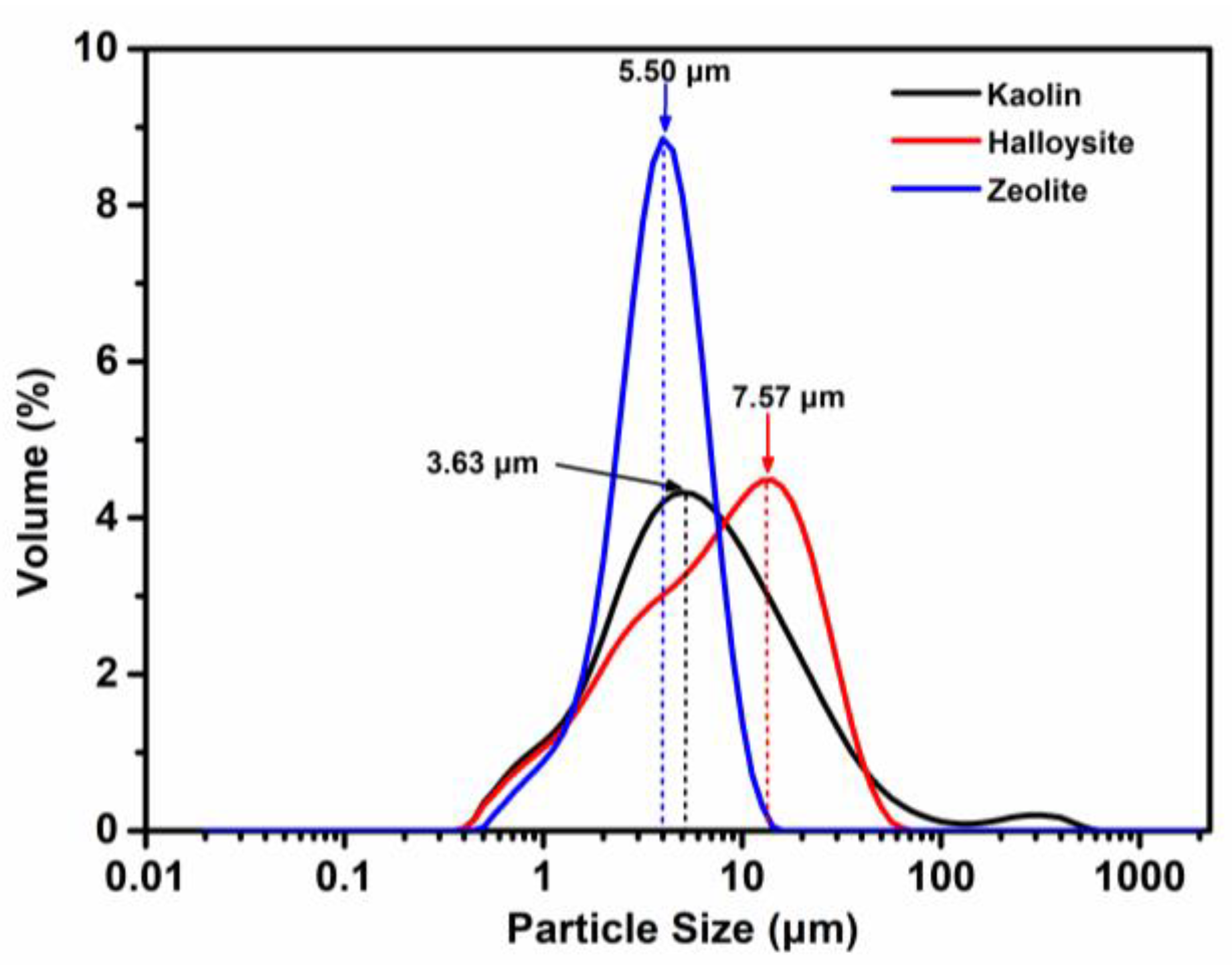
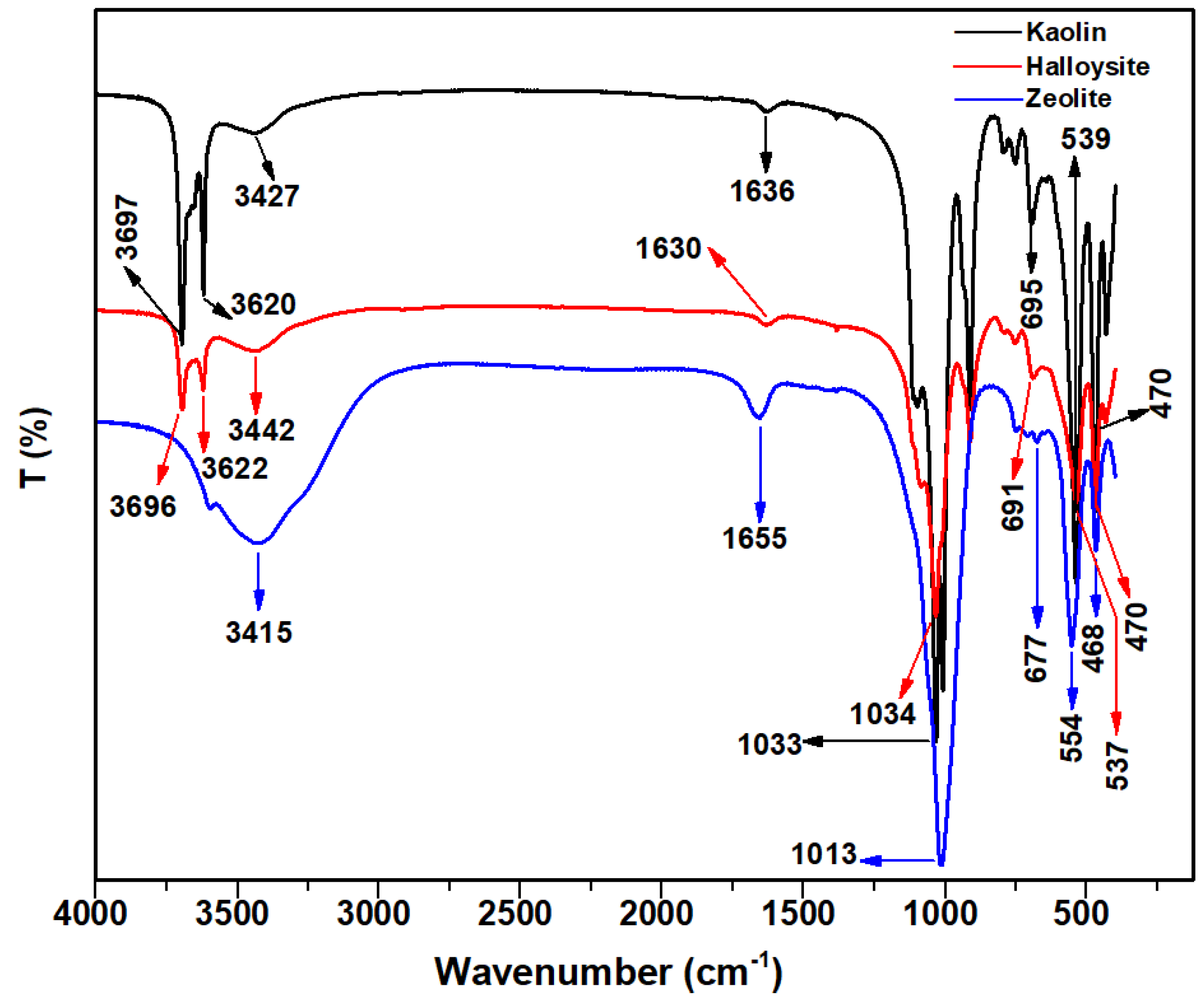
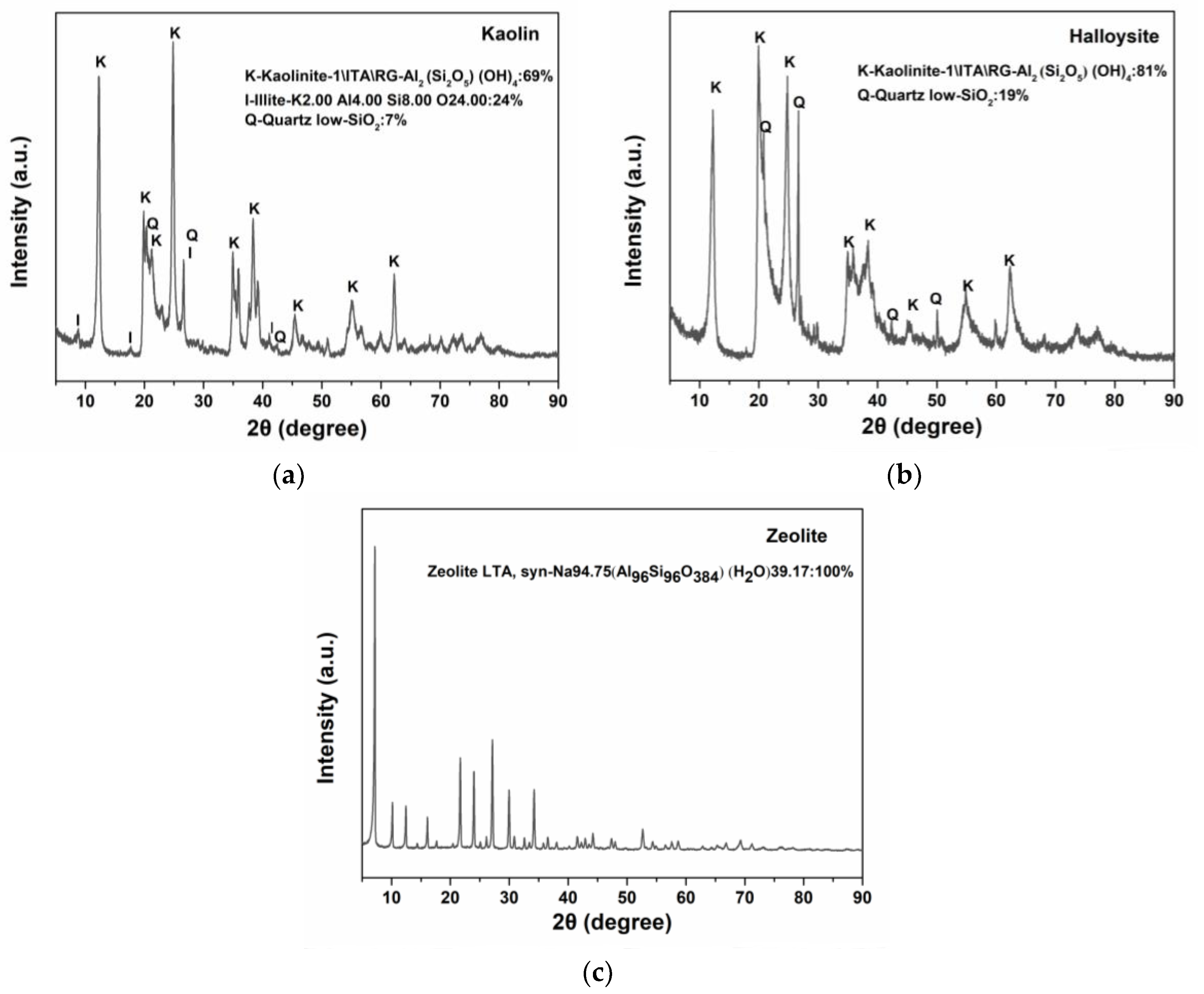
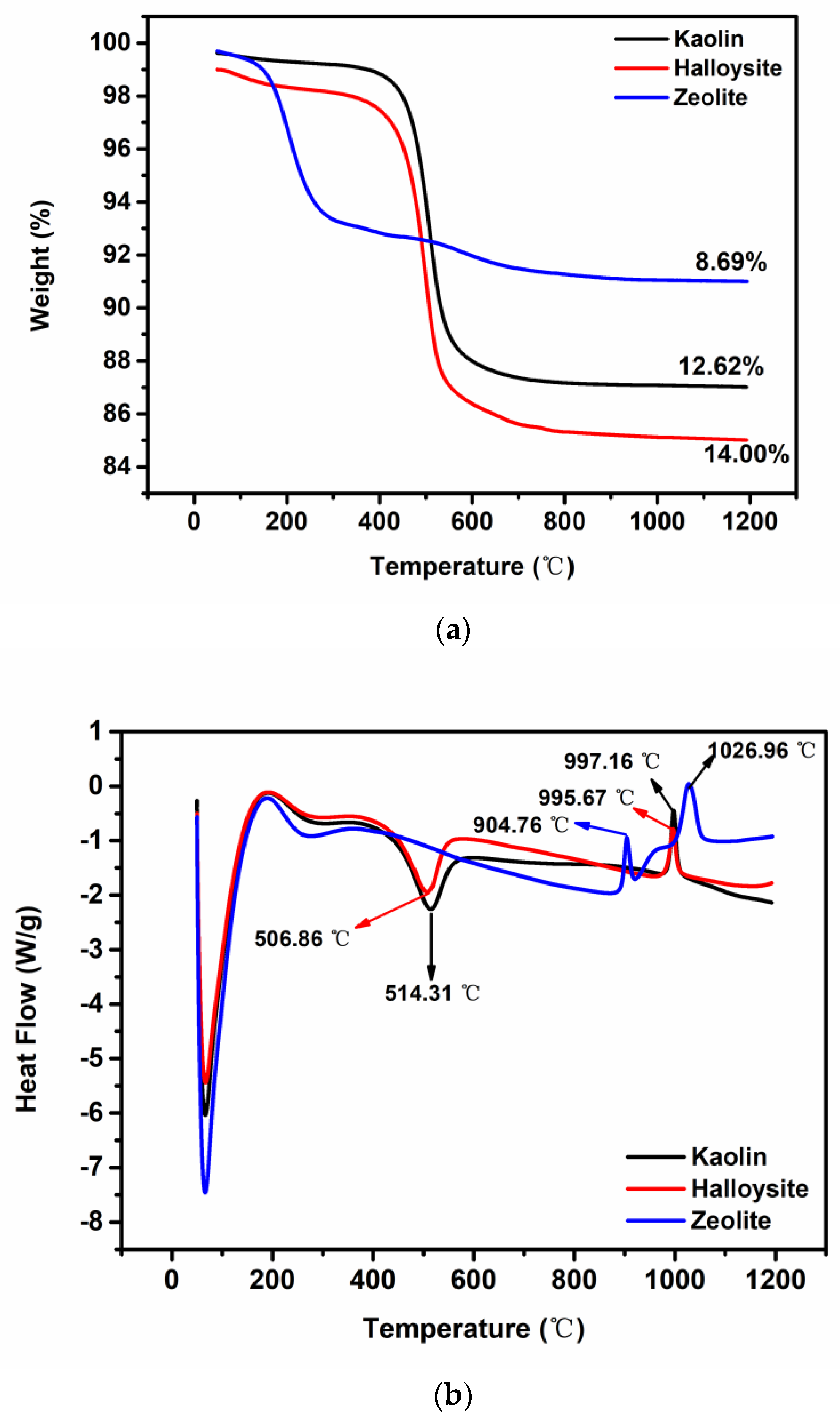
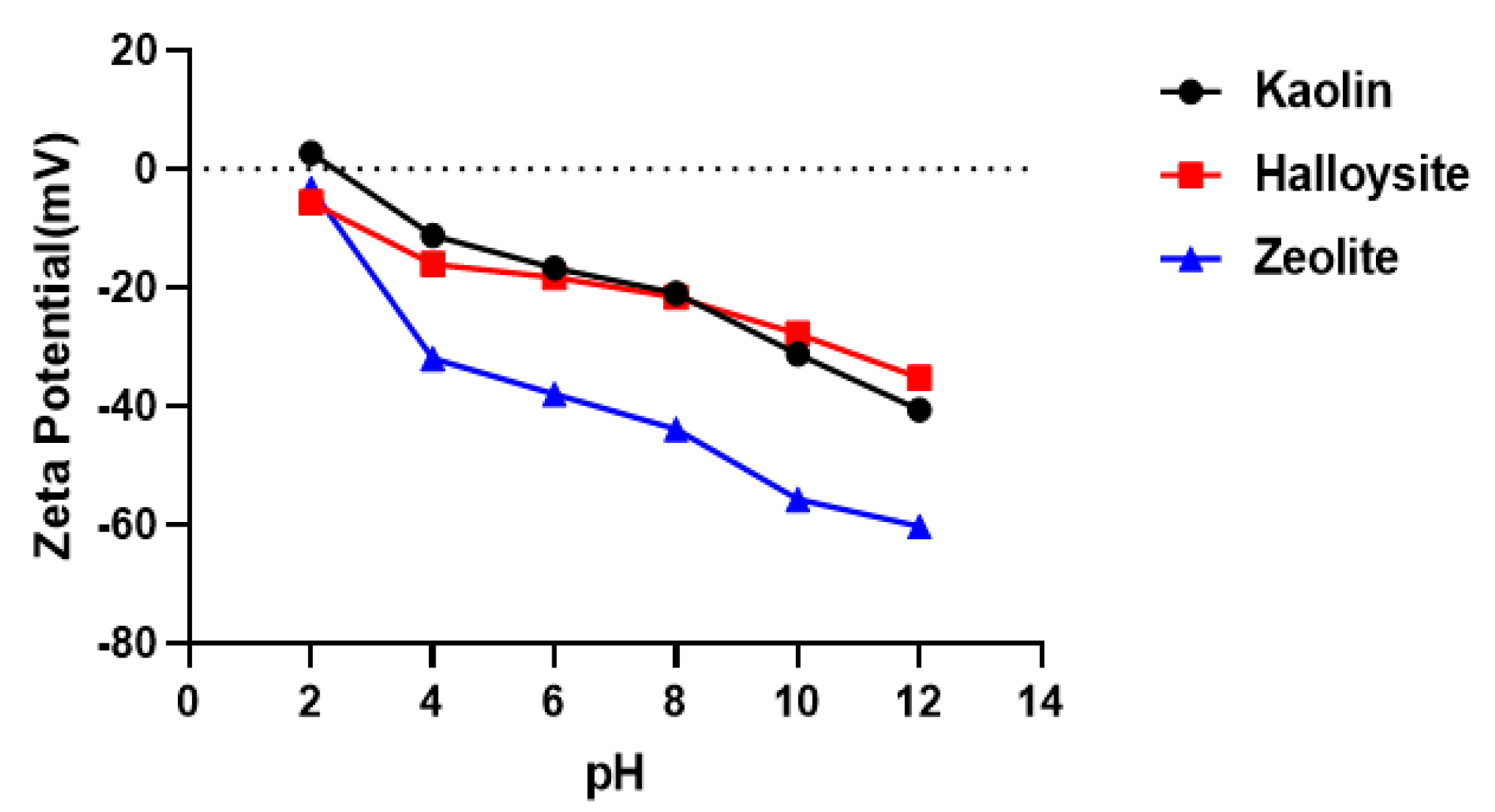


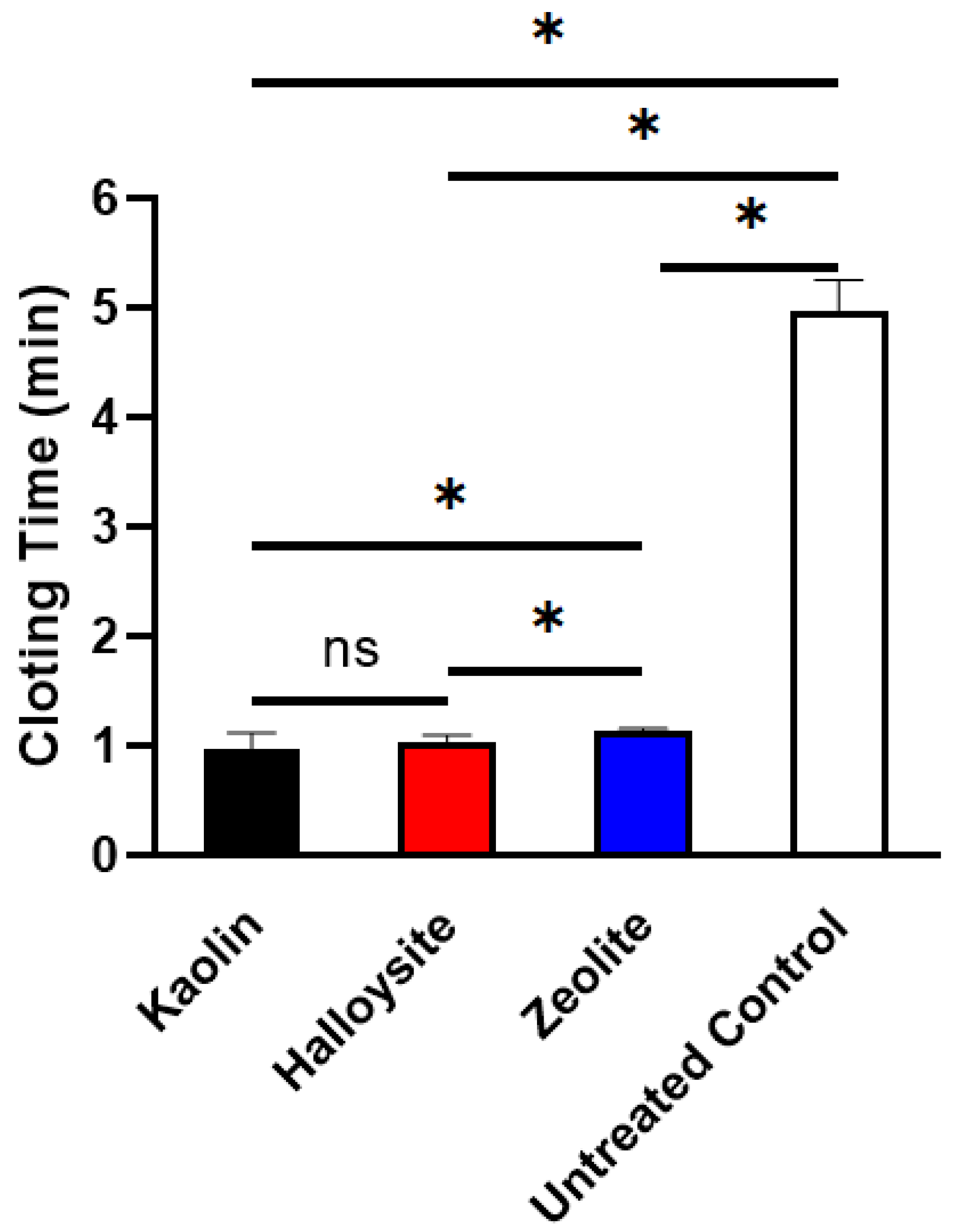
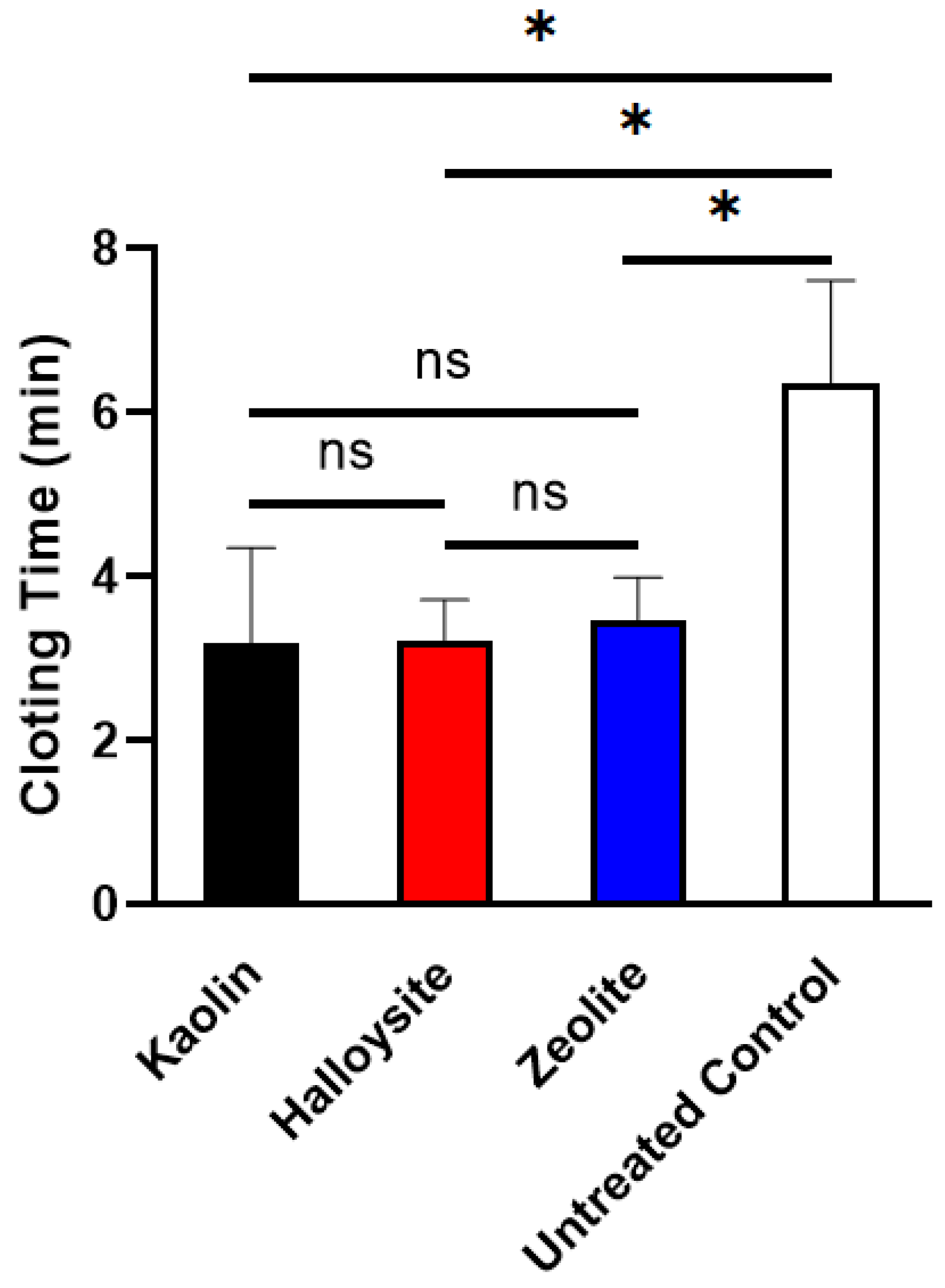
| Oxides | SiO2 | Al2O3 | K2O | Fe2O3 | TiO2 | Na2O | CaO | MgO | ZnO | a LOI |
|---|---|---|---|---|---|---|---|---|---|---|
| Kaolin | 47.23 | 36.03 | 1.65 | 0.99 | 0.44 | 0.496 | 0.02 | 0.03 | 0.00 | 12.59 |
| Halloysite | 46.34 | 35.59 | 0.38 | 1.17 | 0.15 | 0.08 | 0.866 | 0.11 | 0.05 | 14.73 |
| Zeolite | 38.08 | 31.06 | 0.09 | 0.07 | 0.01 | 2.30 | 20.62 | 0.18 | 0.00 | 7.43 |
Disclaimer/Publisher’s Note: The statements, opinions and data contained in all publications are solely those of the individual author(s) and contributor(s) and not of MDPI and/or the editor(s). MDPI and/or the editor(s) disclaim responsibility for any injury to people or property resulting from any ideas, methods, instructions or products referred to in the content. |
© 2023 by the authors. Licensee MDPI, Basel, Switzerland. This article is an open access article distributed under the terms and conditions of the Creative Commons Attribution (CC BY) license (https://creativecommons.org/licenses/by/4.0/).
Share and Cite
Gan, C.; Hu, H.; Meng, Z.; Zhu, X.; Gu, R.; Wu, Z.; Sun, W.; Han, P.; Wang, H.; Dou, G.; et al. Local Clays from China as Alternative Hemostatic Agents. Molecules 2023, 28, 7756. https://doi.org/10.3390/molecules28237756
Gan C, Hu H, Meng Z, Zhu X, Gu R, Wu Z, Sun W, Han P, Wang H, Dou G, et al. Local Clays from China as Alternative Hemostatic Agents. Molecules. 2023; 28(23):7756. https://doi.org/10.3390/molecules28237756
Chicago/Turabian StyleGan, Changjiao, Hongjie Hu, Zhiyun Meng, Xiaoxia Zhu, Ruolan Gu, Zhuona Wu, Wenzhong Sun, Peng Han, Hongliang Wang, Guifang Dou, and et al. 2023. "Local Clays from China as Alternative Hemostatic Agents" Molecules 28, no. 23: 7756. https://doi.org/10.3390/molecules28237756
APA StyleGan, C., Hu, H., Meng, Z., Zhu, X., Gu, R., Wu, Z., Sun, W., Han, P., Wang, H., Dou, G., & Gan, H. (2023). Local Clays from China as Alternative Hemostatic Agents. Molecules, 28(23), 7756. https://doi.org/10.3390/molecules28237756






